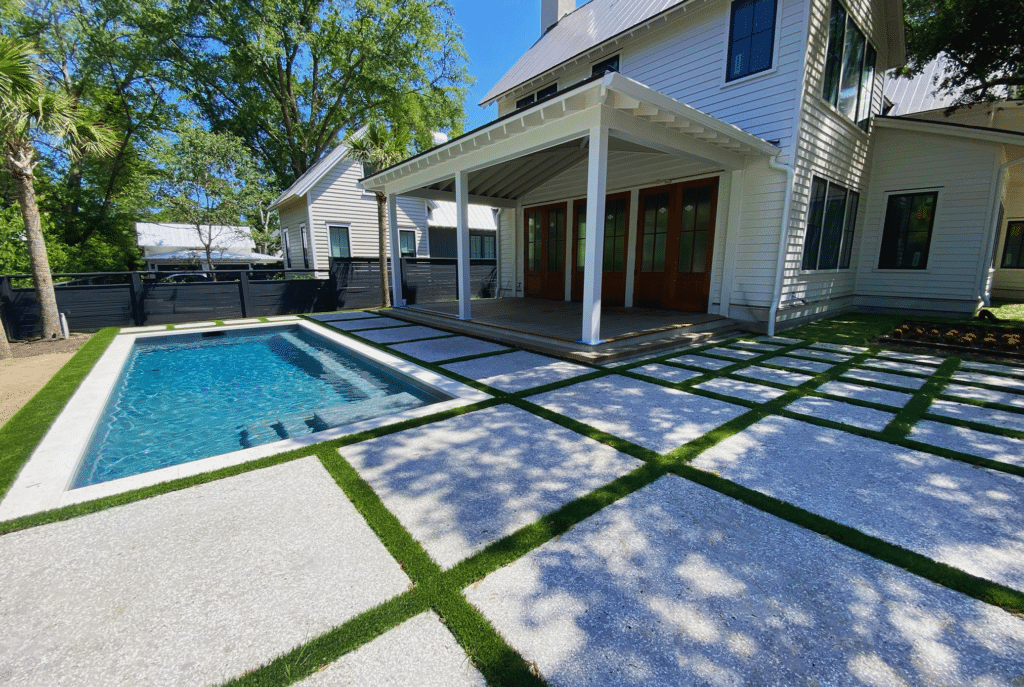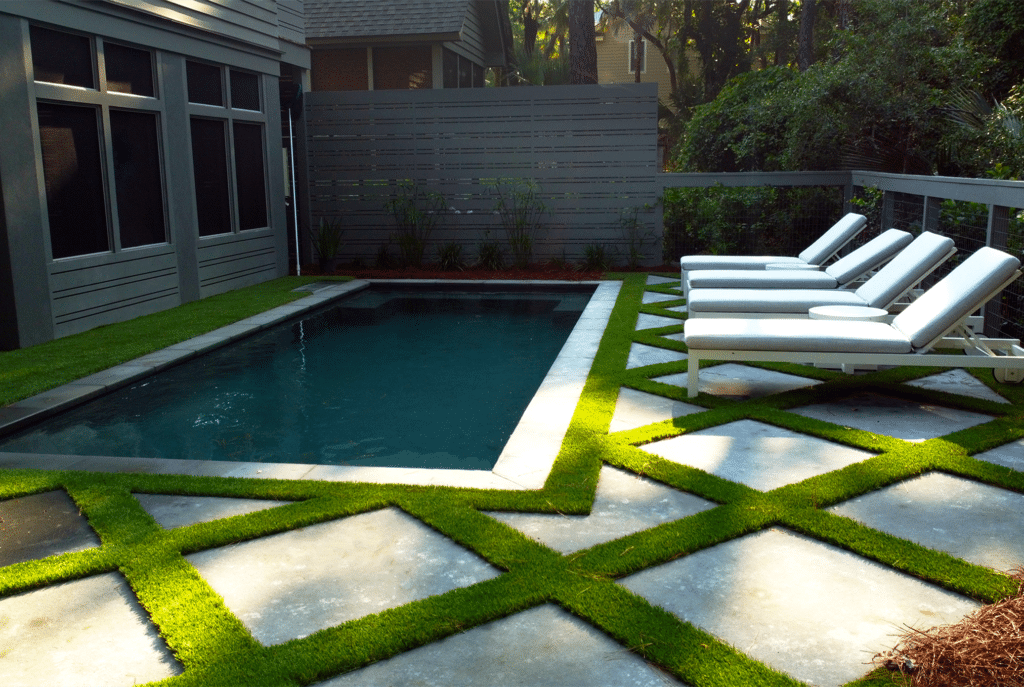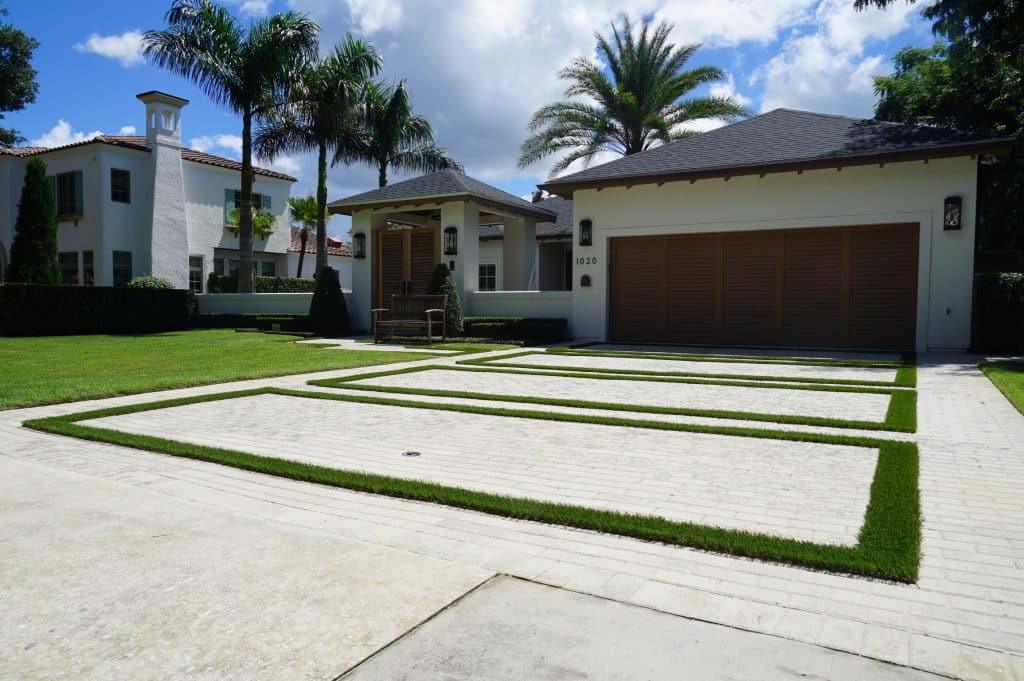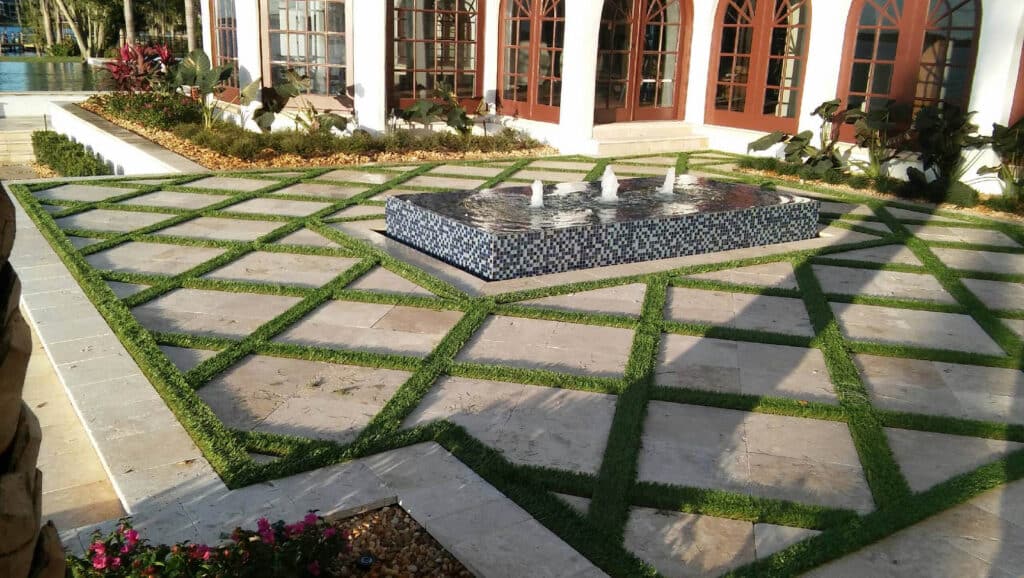Creating a beautiful and efficient home is a goal for many homeowners. One way to achieve this is by enhancing your outdoor spaces with artificial turf. Installing artificial turf strips between pavers can transform your yard into a low-maintenance, year-round green space. This not only adds aesthetic appeal but also contributes to environmental conservation.

In this article, we will guide you through the process of installing artificial turf strips between pavers. We aim to simplify this task, making it accessible even for those without extensive home improvement experience.
We will also highlight the environmental benefits of choosing artificial grass. Plus, we’ll offer practical, cost-effective solutions for enhancing your outdoor living areas.
Whether you’re a DIY enthusiast or considering professional turf installation services, this guide will provide valuable insights. So, let’s dive in and explore how you can create a beautiful, sustainable outdoor space with artificial grass strips.
Artificial grass is an alternative to natural grass. It is designed to mimic the look and feel of real grass, providing a lush, green surface that requires minimal maintenance.
Artificial grass comes in various types, each suited for different applications. When choosing synthetic grass for installation between pavers, consider factors like durability, texture, and color. The right choice will not only enhance the beauty of your outdoor space but also withstand foot traffic and weather conditions.
Artificial turf offers numerous benefits, making it an excellent choice for homeowners. One of the most significant advantages is their low-maintenance nature. Unlike natural grass, artificial grass doesn’t require watering, mowing, or fertilizing, saving you time and effort.

Moreover, artificial turf stays green all year round. This means you can enjoy a vibrant, lush lawn regardless of the season. It’s a great way to enhance the aesthetic appeal of your home.
Artificial turf is also a water-conserving option. With water scarcity becoming a global concern, switching to fake grass can significantly reduce your water usage.
Lastly, synthetic turf is durable and long-lasting. With proper care, it can last for several years, making it a cost-effective solution for homeowners looking to bring some green to their space.
Before you start the installation process, it’s essential to gather all the necessary tools and materials. Having everything at hand will make the process smoother and more efficient.
Here’s a list of what you’ll need:
Remember, using the right tools and materials can significantly impact the final result of your artificial grass installation.
The first step in the installation process is preparing the area between the pavers. This involves cleaning and leveling the surface to ensure a smooth and even base for the artificial grass strips.
Start by removing any debris, such as leaves or stones, from the area. Then, level the surface using a rake or a leveling tool. This step is crucial as it prevents the synthetic turf from shifting over time and promotes longevity.

Remember, a well-prepared surface is key to a successful artificial grass installation. It’s worth taking the time to do this step right.
Once the area is prepared, the next step is to measure the space between the pavers. Use a tape measure to get accurate dimensions. This will help you cut the artificial grass strips to the correct size.
After measuring, mark the dimensions on the back of the artificial turf using a marker. Then, using a sharp utility knife, carefully cut along the marked lines. Remember to cut a little extra to account for any potential measurement errors.
Proper measurement and cutting are essential for a neat and professional-looking installation. Take your time during this step to ensure precision.
After cutting the artificial grass strips, the next step is aligning and laying them properly. This process is crucial for achieving a natural and seamless look. Start by aligning the strips in the same direction as the pavers, ensuring the blades are facing in the same direction for a uniform look. This will create a harmonious pattern and make the synthetic turf blend seamlessly with the pavers.
When laying the strips, ensure they fit snugly between the pavers. There should be no visible gaps or overlaps. This might require some adjustments and trimming, but the effort is worth it for a professional-looking finish.
Remember, patience and precision are key during this step. Take your time to align and lay the strips correctly. This attention to detail will pay off in the long run, enhancing the overall appearance of your outdoor space.
Once the artificial grass strips are in position, it’s time to secure them in place. To secure the strips, use landscape staples or U-shaped metal pins. Push these into the edges of the grass strips, penetrating the underlying base. This will help keep the artificial grass in place, preventing it from shifting or curling.
Remember, securing the grass strips properly is crucial for the longevity of your installation. It helps maintain the aesthetic appeal of your outdoor space over time.
In some cases, you might need to apply infill to your artificial grass strips. Infill helps to weigh down the grass, keeping it in place and giving it a more natural feel underfoot. Certain brands of infill can even help reduce odors, perfect for pet owners. If your artificial turf manufacturer recommends using infill, follow their guidelines on how much to use and how to apply it.
Spread the infill evenly across the grass strips, then use a broom to work it into the grass. This will help the grass blades stand up and look more natural. Remember, the goal is to create a seamless integration of the artificial grass strips between your pavers.
Maintaining your artificial grass strips is relatively straightforward. Unlike natural grass, synthetic grass doesn’t require watering, mowing, or fertilizing. This makes it a low-maintenance option for homeowners looking to save time and resources.
However, it’s still important to keep the area clean. Regularly remove leaves and other debris from the surface of the grass. This can be done using a leaf blower or a broom. If you have pets, make sure to clean up after them promptly to prevent odors and bacteria buildup.
Lastly, if you notice any loose or damaged areas, repair them as soon as possible. This will help to prolong the lifespan of your synthetic grass and keep it looking its best.

Artificial turf has come a long way in recent years. It’s no longer the hard, plastic-looking material of the past. Today’s fake grass is soft, realistic, and safe for children and pets.
Despite this, some misconceptions persist. One common concern is that artificial grass is not environmentally friendly. However, when you consider the water conservation, reduction in chemical fertilizers, and elimination of gas-powered mowing, artificial grass can actually be a more sustainable choice for many homeowners. Plus, all of ProGreen’s products are PFAS safe per EPA-1633.
Installing synthetic grass strips between pavers is a practical and aesthetically pleasing way to enhance your outdoor space. Not only does it provide year-round greenery, but it also contributes to environmental conservation by reducing water usage and eliminating the need for chemical fertilizers.
Moreover, artificial grass is a low-maintenance option that can save you time and effort in the long run. Whether you’re creating a putting green or simply looking to beautify your patio, artificial grass offers versatility and durability.
In conclusion, embracing artificial turf is a step towards creating a more sustainable and efficient home. It’s a choice that benefits not just you and your family, but also the environment.